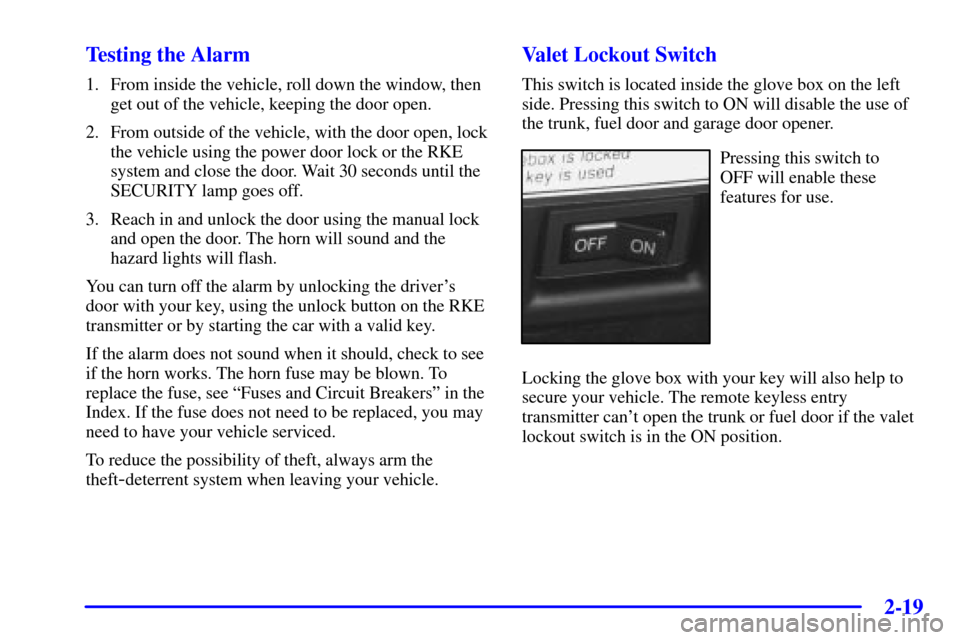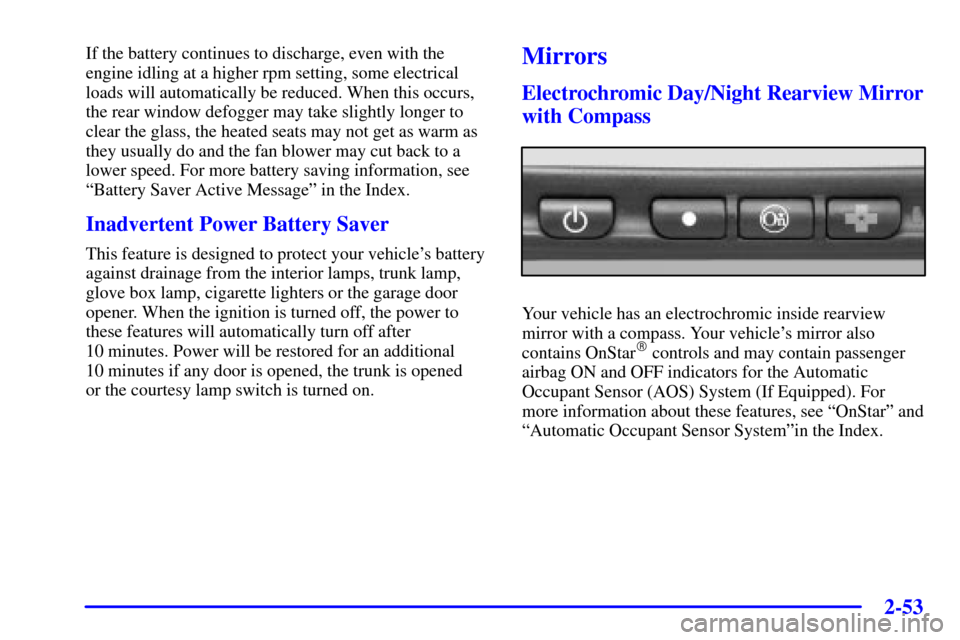Page 84 of 371

2-17
Theft
Vehicle theft is big business, especially in some cities.
Although your vehicle has a number of theft
-deterrent
features, we know that nothing we put on it can make
it impossible to steal. However, there are ways you
can help.
Key in the Ignition
If you leave your vehicle with the keys inside, it's an
easy target for joy riders or professional thieves
-- so
don't do it.
When you park your vehicle and open the driver's door,
you'll hear a chime reminding you to remove your key
from the ignition and take it with you. Always do this.
Your steering wheel will be locked, and so will your
ignition and transaxle. And remember to lock the doors.
Parking at Night
Park in a lighted spot, close all windows and lock your
vehicle. Remember to keep your valuables out of sight.
Put them in a storage area, or take them with you.
Parking Lots
Even if you park in a lot where someone will be
watching your vehicle, it's still best to lock it up and
take your keys. But what if you have to leave your
ignition key?
�If possible, park in a busy, well
-lit area.
�Put your valuables in a storage area, like your
trunk or glove box. Be sure to close and lock the
storage area.
�Close all windows.
�Move the valet lockout switch to ON.
�Lock all doors except the driver's.
�Give the valet key to the valet. Then take the master
key with you.
Page 85 of 371

2-18
Theft-Deterrent System
If the ignition is off and
any door is open, the
SECURITY light will
flash, reminding you to
arm the system.
To arm the system, do the following:
1. Open the door.
2. Lock the door using the power door lock switch with
the door open or the Remote Keyless Entry (RKE)
system. The SECURITY light should come on and
stay on.
3. Close all the doors. The SECURITY light should go
off within approximately 30 seconds.
If a door or a trunk is opened without a key or a remote
keyless entry transmitter, the horn will sound and the
lamps will flash for about 30 seconds.Remember, the theft
-deterrent system won't arm if you
lock the doors with a key or use the manual door lock.
It activates only if you use a power door lock with the
door open or the remote keyless entry transmitter.
To avoid activating the alarm by accident do
the following:
�The vehicle should be locked with the door key or
the manual door lock after the doors are closed if
you don't want to arm the theft
-deterrent system.
�Always unlock a door with a key or use the RKE
system. (Pressing the unlock button on the RKE
transmitter disables the theft
-deterrent system.)
Unlocking a door any other way will activate the
alarm when a door or the trunk is opened.
If you activate the alarm by accident, unlock the driver's
door with your key. You can also turn off the alarm by
using the unlock button on the RKE system, or by
starting the car with a valid key.
Changes or modifications made to this system by other
than an authorized service facility could void
authorization to use the theft system.
Page 86 of 371

2-19
Testing the Alarm
1. From inside the vehicle, roll down the window, then
get out of the vehicle, keeping the door open.
2. From outside of the vehicle, with the door open, lock
the vehicle using the power door lock or the RKE
system and close the door. Wait 30 seconds until the
SECURITY lamp goes off.
3. Reach in and unlock the door using the manual lock
and open the door. The horn will sound and the
hazard lights will flash.
You can turn off the alarm by unlocking the driver's
door with your key, using the unlock button on the RKE
transmitter or by starting the car with a valid key.
If the alarm does not sound when it should, check to see
if the horn works. The horn fuse may be blown. To
replace the fuse, see ªFuses and Circuit Breakersº in the
Index. If the fuse does not need to be replaced, you may
need to have your vehicle serviced.
To reduce the possibility of theft, always arm the
theft
-deterrent system when leaving your vehicle.
Valet Lockout Switch
This switch is located inside the glove box on the left
side. Pressing this switch to ON will disable the use of
the trunk, fuel door and garage door opener.
Pressing this switch to
OFF will enable these
features for use.
Locking the glove box with your key will also help to
secure your vehicle. The remote keyless entry
transmitter can't open the trunk or fuel door if the valet
lockout switch is in the ON position.
Page 120 of 371

2-53
If the battery continues to discharge, even with the
engine idling at a higher rpm setting, some electrical
loads will automatically be reduced. When this occurs,
the rear window defogger may take slightly longer to
clear the glass, the heated seats may not get as warm as
they usually do and the fan blower may cut back to a
lower speed. For more battery saving information, see
ªBattery Saver Active Messageº in the Index.
Inadvertent Power Battery Saver
This feature is designed to protect your vehicle's battery
against drainage from the interior lamps, trunk lamp,
glove box lamp, cigarette lighters or the garage door
opener. When the ignition is turned off, the power to
these features will automatically turn off after
10 minutes. Power will be restored for an additional
10 minutes if any door is opened, the trunk is opened
or the courtesy lamp switch is turned on.
Mirrors
Electrochromic Day/Night Rearview Mirror
with Compass
Your vehicle has an electrochromic inside rearview
mirror with a compass. Your vehicle's mirror also
contains OnStar
� controls and may contain passenger
airbag ON and OFF indicators for the Automatic
Occupant Sensor (AOS) System (If Equipped). For
more information about these features, see ªOnStarº and
ªAutomatic Occupant Sensor Systemºin the Index.
Page 125 of 371

2-58
Rear Storage Armrest
Your vehicle is equipped with a rear seat armrest which
includes an open storage compartment and a dual
cupholder that unfolds for use. Pull the armrest down by
using the attached handle. Push in the lever located at
the end of the armrest to open the storage compartment
and access the cupholder.
Convenience Net
The convenience net is inside the back wall of the trunk.
Put small loads, like grocery bags, behind the net. It can
help keep them from falling over during sharp turns or
quick starts and stops.
The net is not for larger, heavier loads. Store them in the
trunk as far forward as you can. When not using the net,
hook the net to the tabs securing it to the sill plate.
Ashtrays and Cigarette
Lighter (Option)
The ashtrays and cigarette lighters may be ordered
through your dealer.
NOTICE:
Don't put papers or other flammable items into your
ashtrays. Hot cigarettes or other smoking materials
could ignite them, causing a damaging fire.
Front Ashtray
Press on the lower edge of the cover of the console
located below the climate control system to reveal the
front ashtray. To clean the ashtray, lift it out by pulling
on the snuffer.
Rear Ashtray
The rear seat ashtrays are located on the rear door
armrests. To use, lift the lid. For more information,
see your dealer.
Page 138 of 371
2-71
The main components of the instrument panel are:
A. Air Outlets
B. Driver Information Center Buttons
C. Turn Signal/Multifunction Lever
D. HVAC Steering Wheel Controls (or Cellular
Telephone Controls, If Equipped)
E. Instrument Panel Cluster
F. Windshield Wiper/Washer Lever
G. Audio Steering Wheel Controls
H. Ignition Switch
I. Air Vent Control Thumbwheel
J. Hazard Warning Button
K. Audio SystemL. Lamp Controls
M. Hood Release
N. Fuel Door Release
O. Trunk Release
P. Cruise Control
Q. Horn
R. Heated Seat Controls
S. Traction Control Switch
T. Console Shift Lever
U. Convenience Storage/Optional Ashtray
V. Electronic Climate Controls
W. Glove Box
Page 167 of 371

2-100
TRANS HOT IDLE ENGINE - 112: This message
indicates that the transaxle fluid in your vehicle is too
hot. Stop and allow your vehicle to idle until it cools
down or until this message is removed.
TRUNK OPEN
- 24: This message indicates that the
trunk is open when the ignition is on.
TURN SIGNAL ON
- 20: This message is a reminder,
after driving about a mile, that you have the turn signal
on. A multiple chime will also sound when this message
is displayed.
VEHICLE OVERSPEED
- 52: This message is
displayed when the vehicle speed exceeds a certain limit
as required by some export countries. A continuous
chime will also sound when this message is displayed.
Vehicle Programming and
Personalization Features
(If Equipped)
If your vehicle is equipped with personalization,
you can program certain features to a preferred setting
for up to two people. If your vehicle does not have
personalization, then some of the features on your
vehicle have been programmed for all drivers.
On all vehicles, certain features such as climate control
settings, radio preset settings, exterior lighting at
unlock, remote lock and unlock confirmation and
automatic door locks have already been programmed
for your convenience. If the vehicle is equipped with
Personalization, then the seat position, steering column
position (if equipped) and the outside mirror positions
can also be programmed. The navigation screen
preferences (if equipped) will remain at the last
set position.
Page 177 of 371

2-110
A chime will sound the first time an object is detected.
URPA can detect objects 3 inches (7.6 cm) and wider,
and at least 10 inches (25.4 cm) tall, but it cannot detect
objects that are above trunk level. In order for the rear
sensors to recognize an object, it must be within
operating range.
If the URPA system is not functioning properly, the
display will flash red, indicating that there is a problem.
The light will also flash red while driving if a trailer is
attached to your vehicle, or a bicycle or object is on
the back of, or hanging out of your trunk. The light
will continue to flash until the trailer or the object is
removed and your vehicle is driven forward at least
15 mph (25 km/h). It may also flash red if the ultrasonic sensors are not
kept clean. So be sure to keep your rear bumper free of
mud, dirt, snow, ice and slush or the system may not
work properly. If after cleaning the rear bumper and
driving forward at least 15 mph (25 km/h), the display
continues to flash red, see your dealer. It may also flash
red if your vehicle is moving in REVERSE (R) at a
speed greater than 3 mph (5 km/h). Other conditions
that may affect system performance include things like
the vibrations from a jackhammer or the compression
of air brakes on a very large truck.
As always, drivers should use care when backing up
a vehicle. Always look behind you, being sure to
check for other vehicles, obstructions and blind spots.
For cleaning instructions, see ªCleaning Your Vehicleº
in the Index.